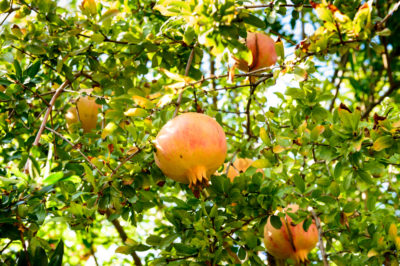About the Pomegranate
Pomegranates grow on shrubs or small trees rarely more than 30 feet tall. There are also some dwarf varieties that stay under five feet. All produce red, orange or pink fragrant flowers in bursts throughout the growing season. Fruit usually ripens from July to October, depending on the variety, and does not store well unless the “berries,” or arils, are frozen.
Choosing Pomegranate Varieties
If you live in USDA Zones 8 to 10, take your pick of varieties. However, many are available no matter where you live:
- Ambrosia – long-lived, pale pink seeds, Zones 7-10
- Angel Red – ruby colored, sweet, ripens September, Zones 8-10
- Emek – Israeli variety, ripens in July, Zones 7-10
- Granada – sweet red fruit, ripens in August, Zones 8-10
- Wonderful – the most common variety, red fruit, Zones 8-10.
Soil for Pomegranates
Pomegranates originated in an area of poor, marginal soils and are not fussy about soil type. Many of the pomegranates in India are actually grown in rocky gravel. They will do well in both neutral and acidic soils, although they prefer a pH of 5.5 to 7.0. The most important characteristic of soils for pomegranate is that they drain well; heavy clay should be amended with coarse sand.
Watering Pomegranates
Naturally adapted to arid areas, pomegranates are very drought tolerant. However, they will flower better and produce more fruit if given deep watering once a week. For pomegranates in containers, try the once weekly routine; if they aren’t doing well or the weather is very dry and windy, water twice weekly. Make sure the water drains completely to prevent rot.
Pomegranate Fertilizer
In average garden soil, pomegranates will generally do fine with no more fertilizer than an organic mulch spread around the tree’s drip line. You may find that they produce more flowers or bigger fruits with fertilizer, however. Choose a 10-10-10 organic fertilizer and use once a month in the growing season. For container plants dilute to half strength with water.
When to Pick Pomegranates
The variety you plant will determine picking time – roughly late July to October. No matter what the color, look for a rough, matte finish. The fruit should be almost hexagonal in shape, with flattened ends. When tapped it will sound tinny. Gently twist a fruit – if ripe it will easily slip off the stem. Once any pomegranate splits, harvest the entire crop.
